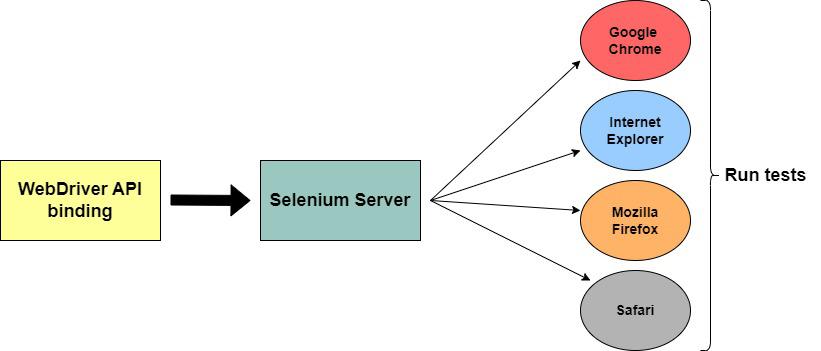Manually testing a website after each minor adjustment can be exhausting. Pressing buttons, completing forms, and exploring various browsers consumes time. It is redundant and susceptible to mistakes. This is the reason Selenium WebDriver is revolutionary. It streamlines browser testing, conserving time and energy while enhancing precision. So, what is Selenium WebDriver?
Selenium WebDriver is a costless tool for automating browsers. It assists developers and testers in managing web browsers through coding. In contrast to Selenium IDE, which captures and plays back tests, WebDriver provides complete control over browser interactions. This enhances the flexibility and strength of automation.
This article will explore optimal methods that enhance effective Selenium web browser automation, enabling comprehensive validation of websites under tight schedules.
Understanding Selenium WebDriver
What is Selenium WebDriver?
- A free tool for testing web browsers automatically.
- Controls browsers directly without using JavaScript.
- Can click buttons, type in fields, and navigate pages.
- Supports top programming languages include java, python etc.
- Works with almost all browsers including chrome, safari etc.
How is Selenium WebDriver Different?
Selenium IDE:
- A simple tool that records and plays back tests.
- No coding skills needed.
- Limited flexibility and browser support.
Selenium WebDriver:
- Allows full control over browser actions using code.
- Works on different browsers and operating systems.
- More powerful and flexible than Selenium IDE.
Selenium Grid:
- Runs tests on multiple devices and browsers at the same time.
- Best for large projects that need fast testing.
Selenium WebDriver is the strongest tool within the Selenium suite. Next, we will examine its main characteristics and the reasons it is vital for automation testing
Key Features of Selenium WebDriver
Selenium WebDriver is mostly used for automating browsers. Here are its main features:
Cross-Browser Compatibility
- Supports major browsers like Chrome, Safari etc.
- Ensures web applications work consistently across different environments.
- Allows running the same test cases on multiple browsers.
Multi-Language Support
- Compatible with Java, Python, C#, JavaScript, Ruby, and more.
- Gives testers the freedom to use their preferred programming language.
- Makes it easy to integrate with various test frameworks.
Direct Interaction with Browsers
- Uses browser drivers to communicate directly with the browser.
- Simulates real user actions like clicking, scrolling, and typing.
- Provides a more accurate and reliable testing experience.
Headless Browser Testing
- Runs tests without opening a visible browser window.
- Speeds up execution by eliminating the need for UI rendering.
- Ideal for CI/CD pipelines where tests run in the background.
Dynamic Element Handling
- Locates web elements using ID, Name, XPath, CSS Selectors, etc.
- Handles dynamically loaded elements with explicit and implicit waits.
- Supports interaction with complex elements like dropdowns, alerts, and pop-ups.
Integration with Testing Frameworks
- Works seamlessly with TestNG, JUnit, and PyTest for structured testing.
- Enables test case management, assertions, and reporting.
- Supports parallel execution to save time.
Handling Multiple Windows & Tabs
- Automates switching between different browser windows and tabs.
- Allows testing of multi-page workflows and pop-up interactions.
Screenshots and Logging
- Captures screenshots for debugging failed tests.
- Helps in tracking errors and maintaining test logs.
Selenium WebDriver’s powerful features make it the backbone of modern browser automation. In the next section, we will explore how it works and its core architecture.
How Selenium WebDriver Works
Selenium WebDriver controls web browsers using special drivers. It follows a client-server model. Test scripts send commands, and WebDriver makes the browser execute them.
1. WebDriver Architecture
- A test script (written in Java, Python, C#, etc.) sends commands to WebDriver.
- WebDriver translates these commands and sends them to the browser driver.
- The browser driver (e.g., ChromeDriver, GeckoDriver) connects Selenium with the browser.
- The browser follows the commands and sends responses back to WebDriver.
This setup makes Selenium WebDriver behave like a real user, ensuring accurate automation.
2. Role of Browser Drivers
Each browser needs its own driver to work with Selenium WebDriver. Some common ones are:
- ChromeDriver – for Google Chrome
- GeckoDriver – for Mozilla Firefox
- EdgeDriver – for Microsoft Edge
- SafariDriver – for Apple Safari
These drivers act as messengers, translating WebDriver commands into browser actions.
3. Running a Test Script
- A test script is written in a supported language like Java or Python.
- WebDriver launches the browser.
- The script performs actions like opening pages, clicking buttons, and typing in forms.
- Assertions check if the expected results match the actual output.
This process helps testers automate web testing smoothly and efficiently.
Setting Up Selenium WebDriver
In order to use Selenium WebDriver refer to the below steps to setup. This includes adding browser drivers, setting up files, and writing a test script.
1. Installing WebDriver for Browsers
Each browser needs a specific WebDriver:
- Google Chrome → Install ChromeDriver.
- Firefox → Use GeckoDriver.
- Edge → Install EdgeDriver.
- Safari → Enable SafariDriver (already included on macOS).
Make sure the WebDriver version matches your browser version to avoid errors.
2. Setting Up Selenium in Different Languages
- Java → Add Selenium JAR files or use Maven (pom.xml).
- Python → Install Selenium with pip install selenium.
- C# → Use NuGet Package Manager to add Selenium WebDriver.
- JavaScript → Install Selenium using npm install selenium-webdriver.
3. Writing Your First Selenium Script
- Import Selenium WebDriver libraries.
- Initialize WebDriver and open a browser.
- Navigate to a webpage.
- Perform actions like clicking, typing, and verifying elements.
- Close the browser when done.
With the right setup, Selenium WebDriver makes testing easy. It handles repeated tasks and helps find bugs faster. This improves the quality of a website or app.
Using Selenium WebDriver with Testing Frameworks
Testing frameworks make Selenium WebDriver more powerful. They help manage tests, track results, and run tests smoothly. Popular ones include TestNG, JUnit, and PyTest.
1. Selenium with TestNG (Java)
- Helps organize and prioritize test cases.
- Has built-in tools to check if tests pass or fail.
- Supports running multiple tests at the same time.
- Creates detailed reports for easy analysis.
2. Selenium with JUnit (Java)
- Simple framework with easy-to-use test markers like @Test.
- Keeps test scripts clean and well-structured.
- Helps check expected and actual results.
- Works well for small and large tests.
3. Selenium with PyTest (Python)
- Easy-to-read test format.
- Allows testing different inputs in one go.
- Runs tests in parallel to save time.
- Creates logs and reports for debugging.
4. Why Use a Testing Framework?
- Better Organization – Keeps tests well-structured.
- Faster Execution – Runs multiple tests together.
- Easier Debugging – Logs help find issues quickly.
- Automatic Reports – Creates reports for test results.
Challenges of Using Selenium WebDriver
Selenium WebDriver is a great tool; however, it comes with certain difficulties. Testers must take these into account before using it
Hard to Learn for Beginners
- Requires coding skills (Java, Python, etc.).
- Setting up and writing scripts can be tricky for new users.
No Built-in Test Reports
- Selenium does not create reports on its own.
- Needs extra tools like TestNG or JUnit for reporting.
Only Works for Websites
- Cannot test desktop or mobile apps.
- Needs Appium or other tools for mobile testing.
Browser and Driver Issues
- WebDriver must match the browser version.
- Browser updates can break old test scripts.
Trouble with Dynamic Elements
- Websites with changing content (React, Angular) can cause errors.
- Requires special handling like waits and strong locators.
No Built-in Parallel Testing
- Selenium cannot run multiple tests at the same time.
- Needs a Selenium Grid or a testing framework for that.
Despite these challenges, Selenium WebDriver remains the most widely used automation tool. Utilizing appropriate tools and techniques can assist in addressing these obstacles.
Future of Selenium WebDriver
Selenium WebDriver is growing and improving. New features will make testing easier, faster, and more reliable.
AI Will Help in Testing
- AI tools will create and update test scripts automatically.
- Smart locators will adjust when the website changes.
- AI will find and fix unstable tests to prevent failures.
More Cloud Testing
- Platforms like LambdaTest provide scalable cloud-based infrastructure for running Selenium tests across 5000+ browser and OS combinations.
- If you’re wondering what is Selenium, it’s a widely used open-source framework for automating web browser interactions. When integrated with LambdaTest, Selenium allows testers to run their test scripts seamlessly in the cloud, eliminating the need for complex local setups.
- Live and automated testing capabilities reduce setup efforts and improve test execution speed.
- Integrating Selenium with LambdaTest Smart UI Testing enables AI-powered visual testing to catch UI inconsistencies automatically.
- Running tests in the cloud will save time and money.
Faster Parallel Testing
- Future versions of Selenium Grid will run tests quicker.
- Large applications will be tested more efficiently.
Better Support for DevOps & CI/CD
- Selenium will work smoothly with Jenkins, GitHub Actions, and other DevOps tools.
- Faster testing means quicker software updates.
Improved Mobile Testing
- Selenium and Appium will work better together for mobile testing.
- Testing for modern web apps (PWAs and hybrid apps) will improve.
With AI-driven automation, cloud scalability, and parallel execution improvements, Selenium WebDriver—combined with tools like LambdaTest—will continue to be the backbone of modern test automation.
Conclusion
Selenium WebDriver has simplified and accelerated web testing. Rather than manually checking websites, testers can create scripts that function like actual users. It is compatible with various programming languages, browsers, and testing tools, which contributes to its popularity
One big reason people love Selenium WebDriver is its flexibility. It works well with tools like TestNG, JUnit, and PyTest. It also connects with cloud platforms like LambdaTest, making it simple to test websites on different browsers. It has some challenges, like handling changing web elements and browser updates, but these can be managed with good practices and extra tools.
The future of Selenium WebDriver looks exciting. AI will help fix tests automatically, locators will become smarter, and cloud testing will improve. Selenium Grid updates will also make running multiple tests at the same time much faster.

